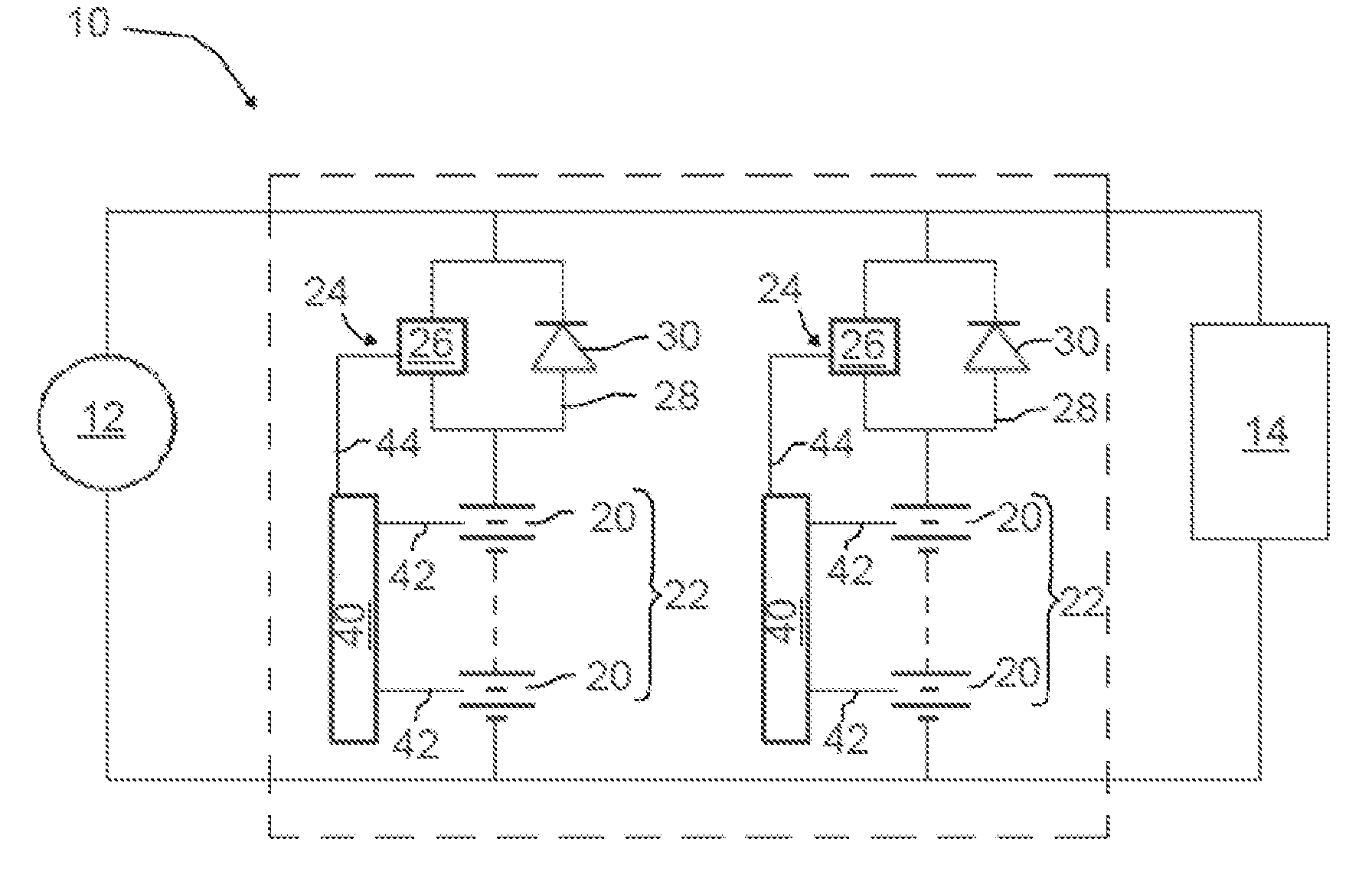System and method for rechargeable battery
a rechargeable battery and system technology, applied in the field of energy storage devices, can solve the problems of premature deterioration of electrochemical cells, affecting the efficiency of charge and discharge operations, and unsatisfactory battery performan
- Summary
- Abstract
- Description
- Claims
- Application Information
AI Technical Summary
Problems solved by technology
Method used
Image
Examples
first embodiment
[0023]Referring to FIG. 1, a rechargeable battery system has a rechargeable battery 10 connected between a source 12 and a load 14. The source 12 may be a variety of electrical power generation devices or systems. In one embodiment, the source 12 is a regenerative brake system of a vehicle, such as an automobile or train. In another embodiment, the source 12 is an internal combustion engine in combination with a generator or alternator configured to produce electrical power. In yet another embodiment, the source 12 is an electricity distribution system, such as a national power grid, electric utility or other commercially available electrical supply. In various embodiments, the source 12 may include one or more different sources of electrical power. The source 12 supplies electrical power to the rechargeable battery 10 to recharge or maintain the charge level of the rechargeable battery 10. In addition, the source 12 may supply electrical power directly to the load 14. In some appli...
second embodiment
[0035]Referring now to FIG. 2, a rechargeable battery system has a rechargeable battery 50 connected between a source 52 and a load 54. The rechargeable battery 50 has a plurality of cell strings 62, each cell string 62 haying a plurality of electrochemical cells 60 connected in series. The rechargeable battery 50 also includes a plurality of discharge regulators 72, with each discharge regulator 72 connected in series with one of the plurality of cell strings 62. Each of the discharge regulators 72 are configured to limit at least one of a discharge voltage and discharge current from a given cell string 62. In one embodiment, the discharge regulators 72 limit the discharge current of a cell string 62 based on the state of charge of the cell string. The discharge regulators 72 are further configured to limit the discharge voltage and discharge current from a given cell string 62 to apply a substantially uniform output voltage to the load 54. In an embodiment, a substantially uniform...
third embodiment
[0039]Referring now to FIG. 3, a rechargeable battery system is illustrated having a rechargeable battery 100 that can be used with a variety of sources and loads, connected through the source connector 106 and load connector 108 respectively. The rechargeable battery 100 has a plurality of cell strings 112, each having a plurality of electrochemical cells 110 connected in series. The rechargeable battery 100 also has both a charge regulator 114 and a discharge regulator 122 in series with each of the cell strings 112. The charge regulators 114 and discharge regulators 122 operate as previously described to control the charge and discharge operation of each cell string 112 of the rechargeable battery 100 and accommodate variation between the cell strings due to differences in performance resulting from age, temperature, failure of electrochemical cells or other factors.
[0040]As shown, charge regulator 114 includes a charge voltage controller 116 in parallel with discharge path 118, ...
PUM
 Login to View More
Login to View More Abstract
Description
Claims
Application Information
 Login to View More
Login to View More - R&D
- Intellectual Property
- Life Sciences
- Materials
- Tech Scout
- Unparalleled Data Quality
- Higher Quality Content
- 60% Fewer Hallucinations
Browse by: Latest US Patents, China's latest patents, Technical Efficacy Thesaurus, Application Domain, Technology Topic, Popular Technical Reports.
© 2025 PatSnap. All rights reserved.Legal|Privacy policy|Modern Slavery Act Transparency Statement|Sitemap|About US| Contact US: help@patsnap.com



